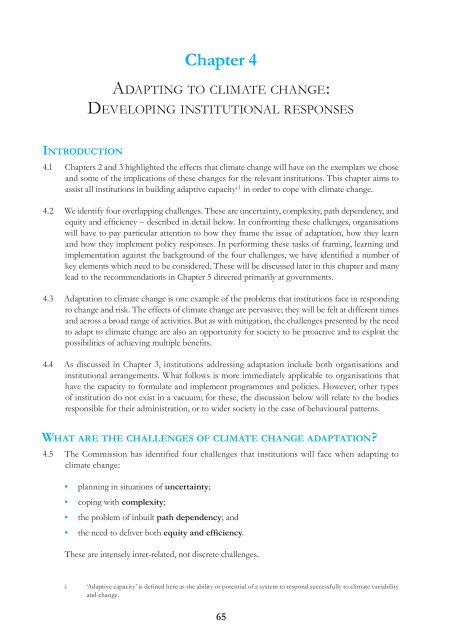Twenty-eighth Report Adapting Institutions to Climate Change Cm ...
Twenty-eighth Report Adapting Institutions to Climate Change Cm ...
Twenty-eighth Report Adapting Institutions to Climate Change Cm ...
Create successful ePaper yourself
Turn your PDF publications into a flip-book with our unique Google optimized e-Paper software.
INTRODUCTION<br />
4.1<br />
4.2<br />
4.3<br />
4.4<br />
Chapter 4<br />
ADAPTING TO CLIMATE CHANGE:<br />
DEVELOPING INSTITUTIONAL RESPONSES<br />
Chapters 2 and 3 highlighted the effects that climate change will have on the exemplars we chose<br />
and some of the implications of these changes for the relevant institutions. This chapter aims <strong>to</strong><br />
assist all institutions in building adaptive capacityi,1 in order <strong>to</strong> cope with climate change.<br />
We identify four overlapping challenges. These are uncertainty, complexity, path dependency, and<br />
equity and efficiency – described in detail below. In confronting these challenges, organisations<br />
will have <strong>to</strong> pay particular attention <strong>to</strong> how they frame the issue of adaptation, how they learn<br />
and how they implement policy responses. In performing these tasks of framing, learning and<br />
implementation against the background of the four challenges, we have identified a number of<br />
key elements which need <strong>to</strong> be considered. These will be discussed later in this chapter and many<br />
lead <strong>to</strong> the recommendations in Chapter 5 directed primarily at governments.<br />
Adaptation <strong>to</strong> climate change is one example of the problems that institutions face in responding<br />
<strong>to</strong> change and risk. The effects of climate change are pervasive; they will be felt at different times<br />
and across a broad range of activities. But as with mitigation, the challenges presented by the need<br />
<strong>to</strong> adapt <strong>to</strong> climate change are also an opportunity for society <strong>to</strong> be proactive and <strong>to</strong> exploit the<br />
possibilities of achieving multiple benefits.<br />
As discussed in Chapter 3, institutions addressing adaptation include both organisations and<br />
institutional arrangements. What follows is more immediately applicable <strong>to</strong> organisations that<br />
have the capacity <strong>to</strong> formulate and implement programmes and policies. However, other types<br />
of institution do not exist in a vacuum; for these, the discussion below will relate <strong>to</strong> the bodies<br />
responsible for their administration, or <strong>to</strong> wider society in the case of behavioural patterns.<br />
WHAT ARE THE CHALLENGES OF CLIMATE CHANGE ADAPTATION?<br />
4.5<br />
The Commission has identified four challenges that institutions will face when adapting <strong>to</strong><br />
climate change:<br />
planning in situations of uncertainty;<br />
coping with complexity;<br />
the problem of inbuilt path dependency; and<br />
the need <strong>to</strong> deliver both equity and efficiency.<br />
These are intensely inter-related, not discrete challenges.<br />
i ‘Adaptive capacity’ is defined here as the ability or potential of a system <strong>to</strong> respond successfully <strong>to</strong> climate variability<br />
and change.<br />
65
















